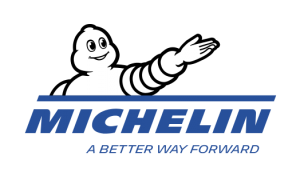When you are on a bike, car, a bus, an airplane as it lands, the only point of contact with the road is the tyre. The tyre makes it easier for you to move around comfortably and safely and can help reduce the energy needed to move forward.
Today, after being used on vehicles, around half of end-of-life tyres in Europe are then exported to third countries. Clearly, this approach is neither desirable nor sustainable.
At Michelin, our vision of a circular economy is divided into four parts: Reduce, Reuse, Recycle and Renew. To reduce the use of tyres, we are providing long lasting performance tyres which contribute to the reduction of CO2 emissions. We also repair, regroove, or replace the tread of tyres to give a second and even multiple lives to tyres. To further advance recycling, we invest in R&D to find innovative and more efficient recovery solutions so that the material in our tyres ultimately find its way into new products such as roads or sources of energy. To renew, because raw materials are finite and therefore precious, we take a sustainable approach to tyre design from the very beginning.
Circular tyres
Today, a quarter of the raw materials we use are renewable. We are now working on integrating materials coming from end-of life tyres and to form a virtuous cycle. To do so, we need to develop technologies which allow us to extract secondary raw materials from end-of-life-tyres. In a product like tyres, this is more complex than it sounds and thus demands exploration across the entire ecosystem.
Michelin is a highly committed partner in the Horizon 2020 BlackCycle project – to design world-first processes to make new tyres from end-of-life tyres. Known technologies in this domain are limited and the BlackCycle project will have to deliver new technical raw materials relevant for tyre production or other technical products. It will proactively integrate these new secondary raw materials and verify the progress on environmental performance.
Creating a new value chain
The first objective of the BlackCycle project is to accelerate innovation and development around secondary raw materials from end-of-life tyres by bringing together all the stakeholders from the start. Secondly, the BlackCycle project aims to create, develop, and optimise a full value chain, from end-of-life-tyres feedstock to secondary raw materials, eliminating waste of resources in all parts of the chain and paying specific attention to the environmental impact.
The BlackCycle project benefits from Horizon 2020 funding up to nearly €12 million out of an overall budget of nearly €16 million. It brings together 13 partners from companies to academia from five countries, with four being EU Member States.
With the end of project currently foreseen for August 2023, partners expect to validate the overall process of sustainable secondary raw materials production derived from end-of-life tyres and the quality of the products. The ultimate objective is ambitious: to establish a high-quality and competitive end-of-life-tyre management and transformation industry within the EU. In fact we expect that one out of two of all European end-of-life tyres will be incorporated into the new circular value chain.
BlackCycle – already a success
In December 2022, Black Cycle announced the production of several tons of the first sustainable Carbon Black from end-of-life tyres and its successful introduction in a Bus Tyre. A major technological breakthrough was made possible by the BlackCycle value chain driven by the stakeholders of the project.
Because, the carbon black content of elastomeric materials is relatively high, the technology applying pyrolysis oil as feedstock for CB production is a major leap towards a more sustainable rubber industry.
From an environmental and consumer perspective, BlackCycle will lead to major improvements. Consumers will be able to access greener alternatives with a much lower environmental footprint thanks to the circular use of resources such as fossil materials or rubber. Globally, substantially lower exports of end-of-life tyres from Europe mean less emissions from shipments and less environmental challenges abroad.
A recipe for the circular economy?
The BlackCycle project is a very encouraging example of what can be achieved under the Horizon framework. By involving academia and the entire value chain and thinking outside the box, we have created a blueprint for other sectors which struggle with recycling and even upcycling of end-of-life products.
However, current EU legislation on waste is a true barrier to tyre circular economy. The generation, transport and use of our secondary raw material remains precarious under the existing EU rules on waste and the end of waste status – which do not support the deployment of a circular economy. To reap the benefits of BlackCycle and strengthen the basis for further investment and innovation, our industry urgently needs a harmonised regulatory framework for the end-of-waste status criteria for end-of-life tyres.
Today’s push for zero-emission mobility also ups the challenges for tyre-makers as it is putting even more strain on the tyres. We are waiting for the European Commission to propose dedicated calls for innovation for developing new tyres ready to meet the challenges raised by the decarbonisation of transport.

